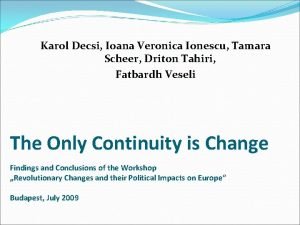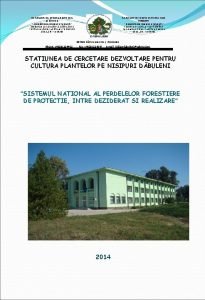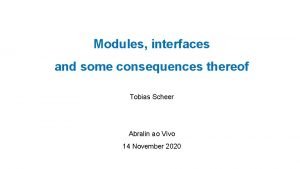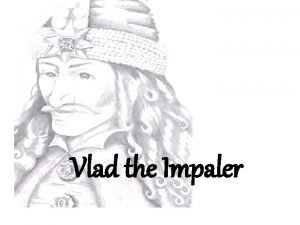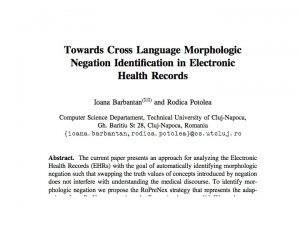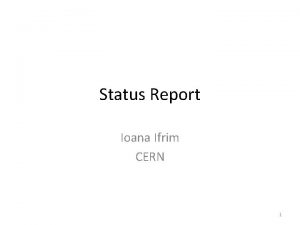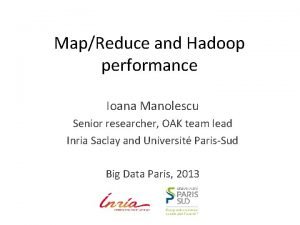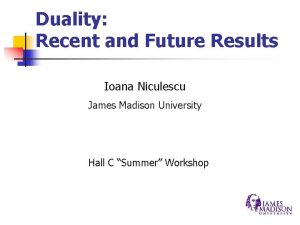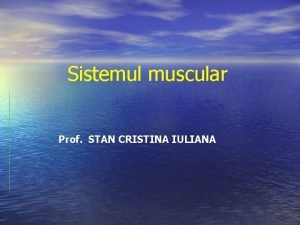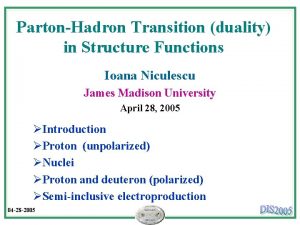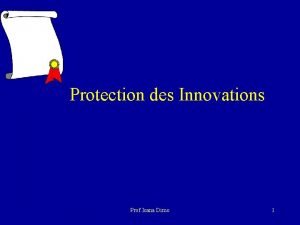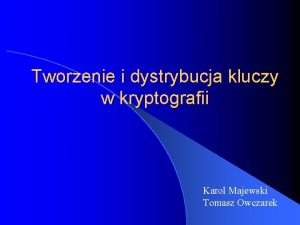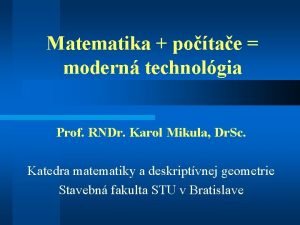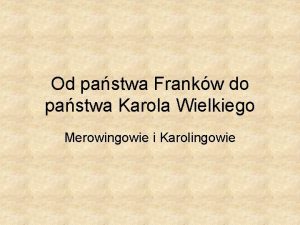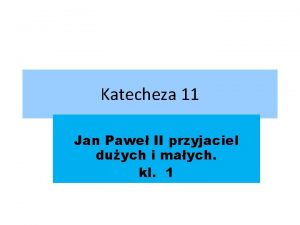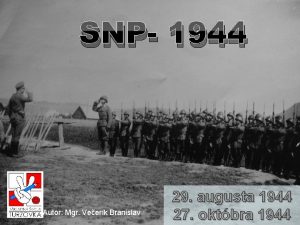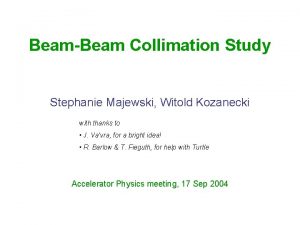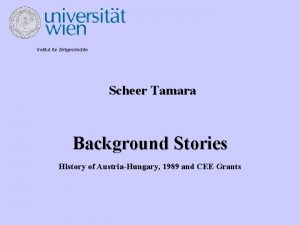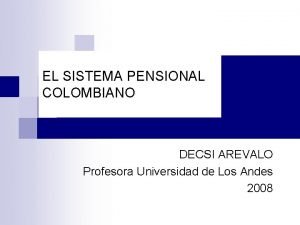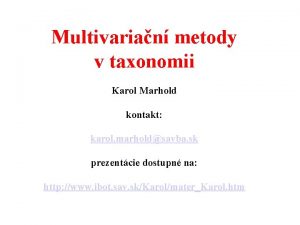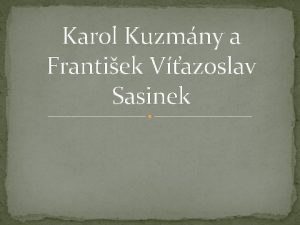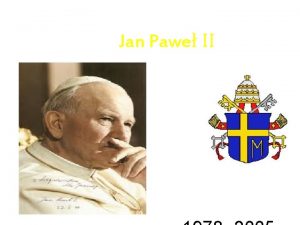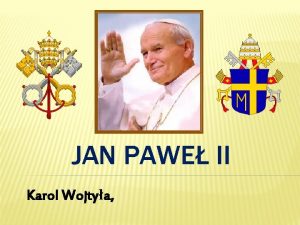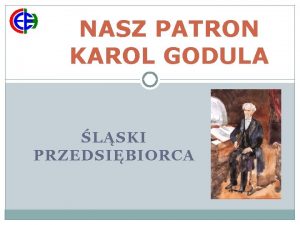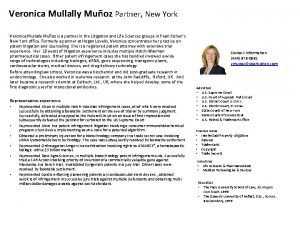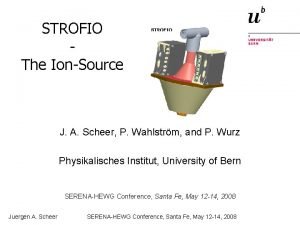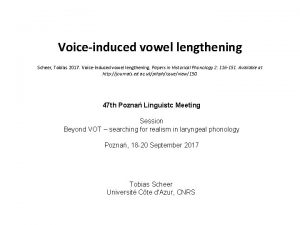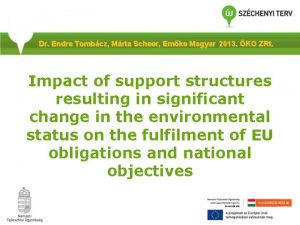Karol Decsi Ioana Veronica Ionescu Tamara Scheer Driton

































- Slides: 33

Karol Decsi, Ioana Veronica Ionescu, Tamara Scheer, Driton Tahiri, Fatbardh Veseli The Only Continuity is Change Findings and Conclusions of the Workshop „Revolutionary Changes and their Political Impacts on Europe“ Budapest, July 2009

First of all. . . Thank you from all of us to the organizers for an exciting opportunity. We enjoyed to get to know each other and the fruitful discussions.

Participants 1 Austrian, 2 Kosovars, 1 Romanian, 1 Slovak *** 1 Historian, 1 Diplomat, 1 Political Scientist , 1 Economist, 1 Computer Scientist

Mapping > Before > Change / Transition > After Media – Security Policy – Gender/Generations – Education/Science – Images on Europe and Neighbours

Kosovo as a newborn country and its integration perspective Fatbardh Veseli, Driton Tahiri

A bit history Position in Yugoslavia Autonomy Changing situation “ 1989 -1999” Education, rights, travelling, minority right Living together

Introduction • Area: Total 10, 908 km² • Population: 2 126 708 (estimate) • Ethnical Groups: Albanians 92 %, Serbs 5. 3 %, Others 2. 7 % • Currency: Euro (€) (EUR) Government Type: Parliamentary Democracy

A newborn state The 1974 Yugoslav Constitution - Kosovo status nearly equivalent to a republic. Serbia’s 1989 constitution significantly limited Kosovo's autonomy In 1991, Kosovo’s Albanian leaders attempted to break free from Serbia using non-violent resistance In Feb. 1998, the Yugoslav army and Serbian police began fighting against the Kosovo Liberation Army, but their scorched-earth tactics were concentrated on ethnic Albanian civilians On March 24, 1999, NATO began launching air strikes. June 1999 – UN Administration took place 17 February 2008 – Declaration of Independence Recognition by countries individually

Facts and statistics 61 out of 192 United Nations (UN) Member States (31. 77%) 22 out of 27 European Union (EU) Member States (81. 48%) Member of CEFTA since 1 May, 2007 Member of IMF, WB (recently)

Geopolitical situation of Kosova/o

Current situation Political situation Recognition Police Army Living together (Internationals, Serbs and Albanians) Economic development

Issues to deal with International representation Formal relations with the EU International Cooperation Traveling (passport recognition) Interpol Regional cooperation Country code International Law Integration of the Region (How? )

Further information Government of Kosovo www. rks-gov. net Who recognized Kosovo www. kosovothanksyou. com Kosovo: What Everyone Needs to Know by Tim Judah

E-Government: Key for extended democracy Karol Decsi

Administration Research Purpose to consider: functions of the E-Government the change of the administration applications and its process the improve of the administration impact of public opinion

E-Government a key to the modernization of the public administration the administration of government by means of electronic technology enables participation via online application complete businesses on PC simplification of work routines and processes between state institutions the government and citizens or businesses

E-Government Austria in Europe an e-Government forerunner country of the "bureaucratic" tradition historical rooted with Slovakia Tendency: Adaptation of directions and politics of the EU tries to approach the Austrian strategy long transformation process

Impact of Public Opinion public opinion influences public policy the more salient an issue to the public, the stronger the relationship is likely to be the relationship is threatened by the power of interest organizations, political parties, and economic elites

E-Government in Slovakia after accession to EU: pushing Slovak government towards formulating clearer policies fulfilling European policy (e. Europe) GOAL: providing modern and effective online public services STATUS quo: quo low internet access, legal environment does not meet EU standards (or very slowly implementation)

E-Government Benchmarking 2007 Quelle: Cap Gemini

e-Governance changing structures in the system of the governing: New Public Management Use of Information and Communication technology participation possibilities through electronic procedures modern public authorities administrate transparently, democratically and electronically

Citizen Card

EU Strategy for the Danube Region Ioana Veronica Ionescu


History lessons 1856 -Treaty of Paris– ending of Crimea War resulting into the arrangements over the Danube legal regime between Russia on the one hand, and Ottomans, France and UK an the other, providing the neutrality of the Black Sea and the international free navigation on the Danube River European Danube Commission, Galati, Moldova. 1948 – the “new” Danube Commission was set up in order to provide rules for the navigation on the Danube River – Belgrade Convention, signed on 18 th of August, still in force, must be revised.

Current format of cooperation 2002 - Danube Cooperation Process (common initiative of AT, RO, COM and the Stability Pact) was set up in order to enhance the economic cooperation in the region and to develop the dialog between its 13 members politically.

The future of the Danube Region Territorial cohesion – a new debate proposed by the European Commission in October 2008, when the Green Paper on Territorial Cohesion was published. 1. Europe of the macro-regions: Baltic Sea Strategy – initiative of Nordic States around the Baltic Sea (2005). Union for Mediterranean (Union pour la Méditerranée) initially proposed by France (2008). EU Strategy for the Danube Region, a very young proposal of Austria and Romania (2008) that was welcomed by the European Council of 18 -19 June 2009. 2. 3.

EU Strategy for the Danube Region Presidency Conclusions of the European Council, 18 -19 June 2009: III. Climate change and sustainable development 34. “(…) It also invites the Commission to present an EU strategy for the Danube region before the end of 2010”. www. consilium. europa. eu/uedocs/cms_data/docs/p ressdata/en/ec/108622. pdf

EU Strategy for the Danube Region The EU Strategy of the Danube Region will be an European one and every Danube country is invited to contribute.

The future of the Danube Region Why do we need a Strategy of the Danube Region in the future? What’s new? How can this Strategy support the equilibrated and harmonious development of our countries?

Future challenges To be continued …

Resume > More than one important „break point“ after 1989 > Policy has to take into consideration public opinion > More heterogenous interests to find a solution since 1989

Karol Decsi, Ioana Veronica Ionescu, Tamara Scheer, Driton Tahiri, Fatbardh Veseli The Only Continuity is Change Findings of the Workshop „Revolutionary Changes and their Political Impacts on Europe“ Budapest, July 2009
 Denisa loana lonescu
Denisa loana lonescu Tamara ionescu veterinar
Tamara ionescu veterinar Scheer heizsysteme
Scheer heizsysteme Tobias scheer
Tobias scheer Andrei ionescu deloitte
Andrei ionescu deloitte Liceul ecologic pitesti
Liceul ecologic pitesti Ioana dragalin
Ioana dragalin Ioana radu romante
Ioana radu romante Ioana dimo
Ioana dimo Ioana burla
Ioana burla Ioanna stais
Ioanna stais Ioana dimo
Ioana dimo Ioana dewandeler
Ioana dewandeler Ioana manolescu
Ioana manolescu Ioana burla
Ioana burla Muschi subclavicular
Muschi subclavicular Andreea hamza
Andreea hamza Ioana burla
Ioana burla Bucla volum presiune
Bucla volum presiune Ioana popescu nud
Ioana popescu nud Ioana dimo
Ioana dimo Ioana lupescu
Ioana lupescu Karol chlebana
Karol chlebana L
L Intersubjectivity requires accepting
Intersubjectivity requires accepting Henryk dąbrowski pan tadeusz
Henryk dąbrowski pan tadeusz Canis donnezani
Canis donnezani Karol mikula
Karol mikula Nauczyciel karola wielkiego
Nauczyciel karola wielkiego Karol wojtyła gdy był mały piosenka
Karol wojtyła gdy był mały piosenka Polikarpov i-16
Polikarpov i-16 Karol wojtyla
Karol wojtyla Witold kozanecki
Witold kozanecki Karol szymczyk
Karol szymczyk
